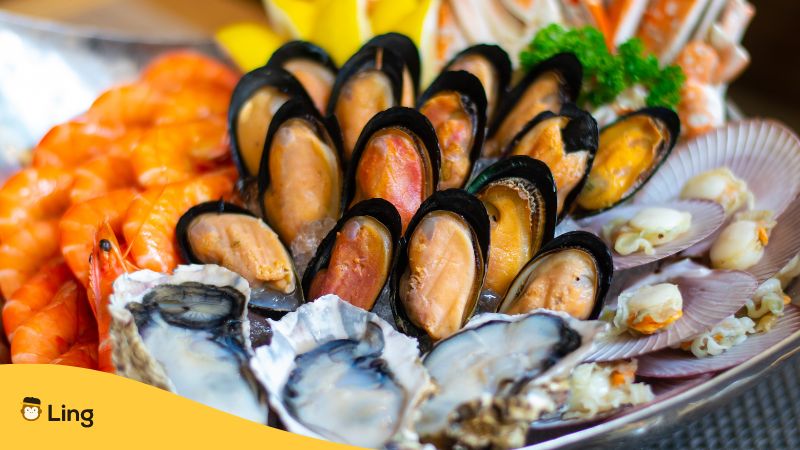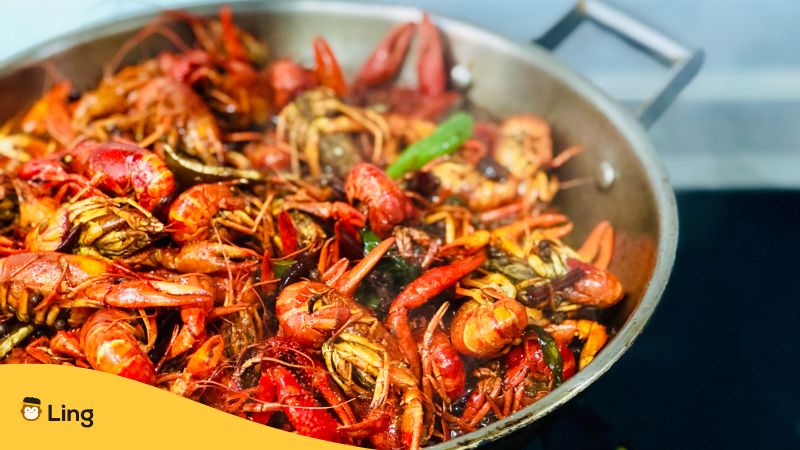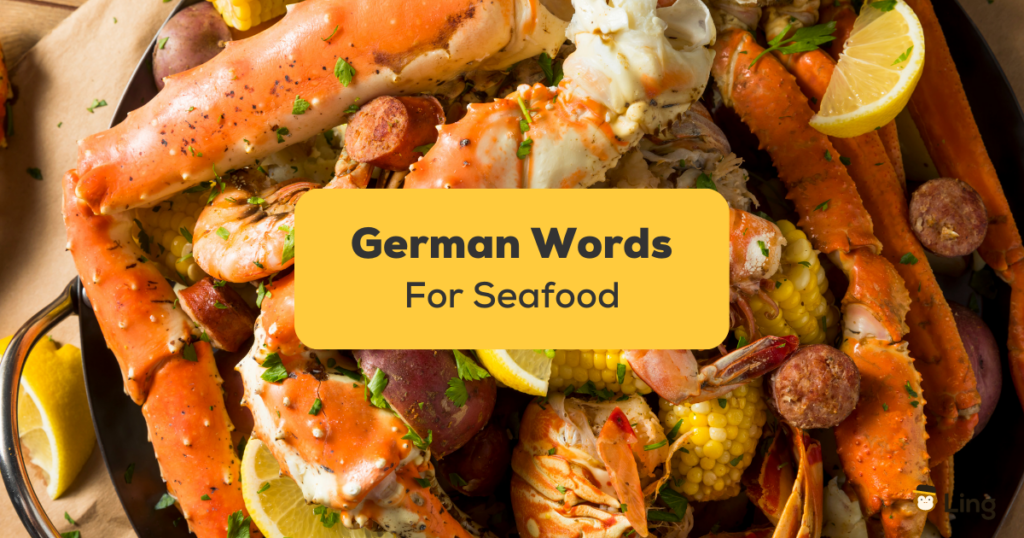Seafood or die Meeresfrüchte plays a significant role in the culinary landscape of Germany. With its extensive coastline and vibrant fishing industry, the country boasts a diverse array of seafood dishes that are enjoyed by locals and visitors alike. In this post, we’ll go over the top German words for seafood and highlight the popular dishes related to it. If you’re ready for a gastronomic & linguistic adventure all rolled into one, then this post is for you! Let’s begin!
There’s no denying that German cuisine is renowned for its hearty flavors and diverse ingredients. Many often things that the country is all about those pretzels and potato-based dishes, but there’s actually a lot more going on that you should know about! For instance, did you know that the Germans have some of the *chef’s kiss* recipes for seafood? Yep, you read that right!
When I arrived in Germany a few years back, I came with a preconceived notion that the country was all about Bratwurst and Sauerkraut. Little did I know that seafood had a special place in the hearts of the locals. That’s right, seafood! From the tantalizing taste of herring to the delicate sweetness of shrimp and the oh-so-rich texture of salmon, Germans have mastered the art of incorporating seafood into their traditional dishes. And let me tell you, it’s no surprise that you can find it in the finest restaurants across the country!
You might be surprised to learn that Germany, despite having a limited coastline, has developed a deep love for seafood. While the country’s access to the sea may not be as extensive as some coastal nations, Germans have found creative ways to incorporate seafood into their culinary traditions. Moreover, Germany’s cultural diversity plays a significant role in shaping its seafood cuisine. The country is home to a large number of immigrants from various European countries, especially from Eastern Europe and Mediterranean regions. These immigrants have introduced their own culinary traditions, including a fondness for seafood, which has further enriched Germany’s gastronomic landscape.
In fact, in cities like Berlin, Munich, and Hamburg, you’ll find a thriving restaurant scene that celebrates seafood in all its forms. From classic fish dishes to innovative seafood creations, German chefs showcase their culinary prowess by incorporating the freshest catch into their menus. Whether it’s a traditional fish stew or a contemporary seafood fusion, Germans appreciate and relish the flavors of the ocean, even if they’re miles away from the coast.
So, while Germany may have limited coastal access, its love for seafood knows no bounds. Through a combination of freshwater delights, cultural influences, and culinary creativity, Germans have developed a profound appreciation for seafood that continues to delight both locals and visitors alike.
But hey, before we dive into the tantalizing details of these delectable dishes, let’s first brush up on the lingo, shall we?

Seafood Types In German
Seafood encompasses a wide variety of culinary delights, each with its own distinct characteristics and flavors. In German cuisine, you’ll find an array of seafood options that cater to different tastes and preferences. Here are some common types of seafood categorized for easy reference.
To effectively use the German words for seafood in conversation or written communication, it’s helpful to understand how to incorporate them into sentences. Here’s a simple pattern you can use: Ich esse genre + Seafood Type. Let’s see how this pattern works based on the examples below.
- I like eating saltwater fish – Ich esse gerne Salzwasserfische.
- I like eating freshwater fish – Ich esse gerne Süßwasserfische.
- I like eating shellfish – Ich esse gerne Schalentiere.
- I like eating mollusks – Ich esse gerne Weichtiere.
- I like eating crustaceans – Ich esse gerne Krebstiere.

German Terminology For Seafood
In German cuisine, seafood plays a prominent role, offering a delightful array of flavors and textures. To fully appreciate and navigate the world of German seafood, it’s essential to familiarize yourself with the German terminology used to describe various types of seafood. Here is a guide to help you understand the German names for the ten most common seafood.
1. Fisch (Fish): Fisch is a general term encompassing a wide variety of fish species. From delicate trout (Forelle) to robust salmon (Lachs), the word “Fisch” covers the vast array of finned creatures found in German waters and beyond.
2. Krabben (Crabs): Krabben refers specifically to crabs in German. Whether you’re indulging in the succulent meat of the North Sea crab (Nordsee Krabben) or savoring the flavors of other crab varieties, the word “Krabben” is your gateway to exploring these crustacean delights.
3. Garnelen (Shrimp): Garnelen is the term used for shrimp in German. It encompasses a variety of shrimp species, from the small, tender North Sea shrimp (Nordsee Garnelen) to the larger and more robust tiger shrimp (Tigergarnelen).
4. Muscheln (Mussels): Muscheln, meaning mussels, refers to the bivalve mollusks that are highly regarded in German cuisine. Whether you’re enjoying Muscheln Rheinische Art (mussels prepared in the Rhineland style) or exploring other delicious preparations, the word “Muscheln” will guide you to these briny delicacies.
5. Scampi: In German, Scampi is used to refer to large shrimp or prawns. Whether you prefer them grilled (gegrillte Scampi) or as a key ingredient in flavorful dishes, the term “Scampi” will lead you to these delectable crustaceans.
6. Aal (Eel): Aal represents eel, a rich and flavorful fish commonly found in German cuisine. Whether it’s enjoying smoked eel (geräucherter Aal) or savoring it in traditional dishes, the term “Aal” will guide you to this unique seafood option.
7. Lachs (Salmon): Lachs, meaning salmon, are a popular fish known for its distinct taste and rich texture. Whether you prefer it grilled, smoked, or poached, the word “Lachs” is your entry point to exploring the world of this versatile and sought-after seafood.
8. Forelle (Trout): Forelle translates to trout, a freshwater fish highly regarded for its delicate flavor. Whether you’re savoring Forelle Müllerin Art (trout meunière) or enjoying it in other culinary preparations, the term “Forelle” will guide you to this beloved fish.
9. Kabeljau (Cod): Kabeljau denotes cod, a popular white fish in Germany. Whether you’re relishing in the flaky texture of Kabeljaufilet (cod fillet) or enjoying other cod-based dishes, the term “Kabeljau” will lead you to this versatile and widely appreciated seafood.
10. Heilbutt (Halibut): Heilbutt refers to halibut, a flatfish known for its firm, white flesh, and delicate flavor. Whether you’re indulging in Gravad Heilbutt (cured halibut) or exploring other halibut-based creations, the term “Heilbutt” will guide you to this prized seafood option.
Seafood Preparation In German Cuisine
German cuisine offers a variety of methods to prepare seafood, each designed to highlight the natural flavors of the ingredients. Here are some common cooking techniques used.
- Grillen: Grilling seafood is a popular method in German cuisine. Whether it’s whole fish, shrimp skewers, or fillets, grilling imparts a smoky flavor while retaining the natural juiciness of the seafood.
- Räuchern: Smoking is another traditional method of preparing seafood in Germany. Fish, such as salmon or eel, is often hot or cold-smoked, resulting in a rich, smoky taste.
- Poachieren: Poaching seafood involves gently simmering it in a flavorful liquid, such as broth or white wine. This method is commonly used for delicate fish like trout or soles.
- Panieren und Frittieren: Breading and frying seafood, such as shrimp or fish fillets, creates a crispy exterior while keeping the interior moist and tender. This technique is used for dishes like fish schnitzel or breaded shrimp.
These terms will help you understand and communicate the specific cooking methods used in German seafood preparations. Whether you’re grilling fish, smoking eel, poaching salmon, or enjoying breaded and fried shrimp, these translations will enhance your understanding of German seafood cooking techniques.
Learn German With Ling
As we learned in this post, German cuisine embraces the richness of seafood, offering a wide range of dishes that showcase the flavors of the sea. From the iconic Matjes Herring to the delicate Nordsee Crab, seafood holds a special place in German culinary traditions. Want to further enhance your skills in the German language? It’s time to try out the Ling app!
Ling is a comprehensive language-learning resource that provides a dynamic and interactive platform for mastering the German language. With Ling, you can embark on a journey to deepen your understanding of German vocabulary, pronunciation, grammar, and conversational skills. The app offers a variety of engaging lessons, exercises, and quizzes tailored to your proficiency level.
Ready to give it a try? Download it today from the App Store or Play Store today to get started!



































































